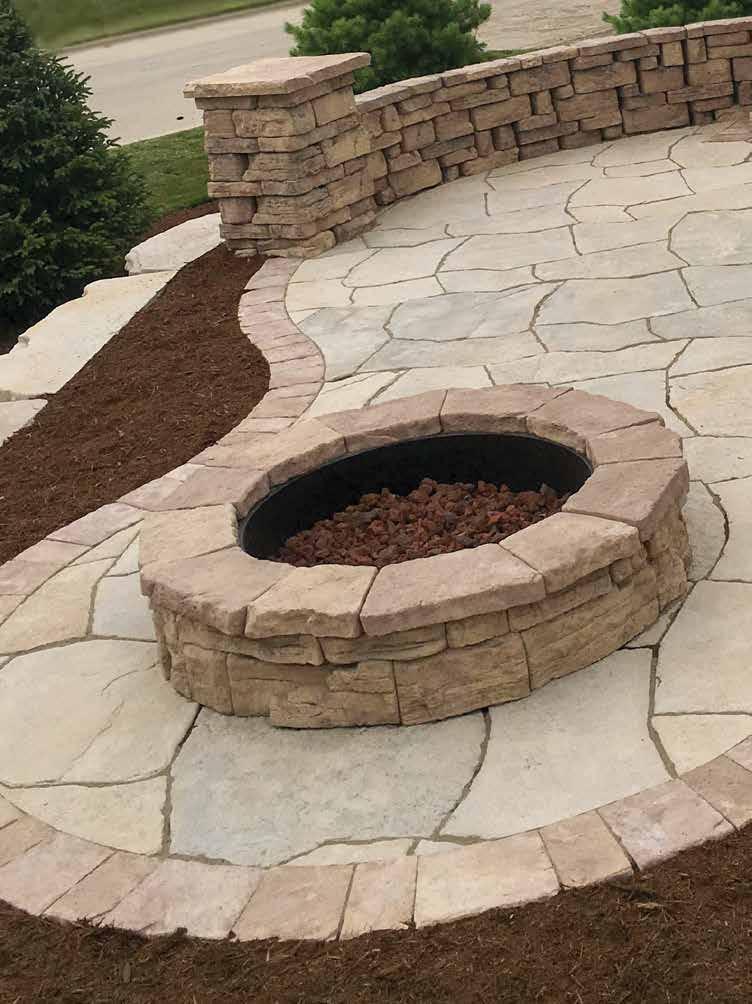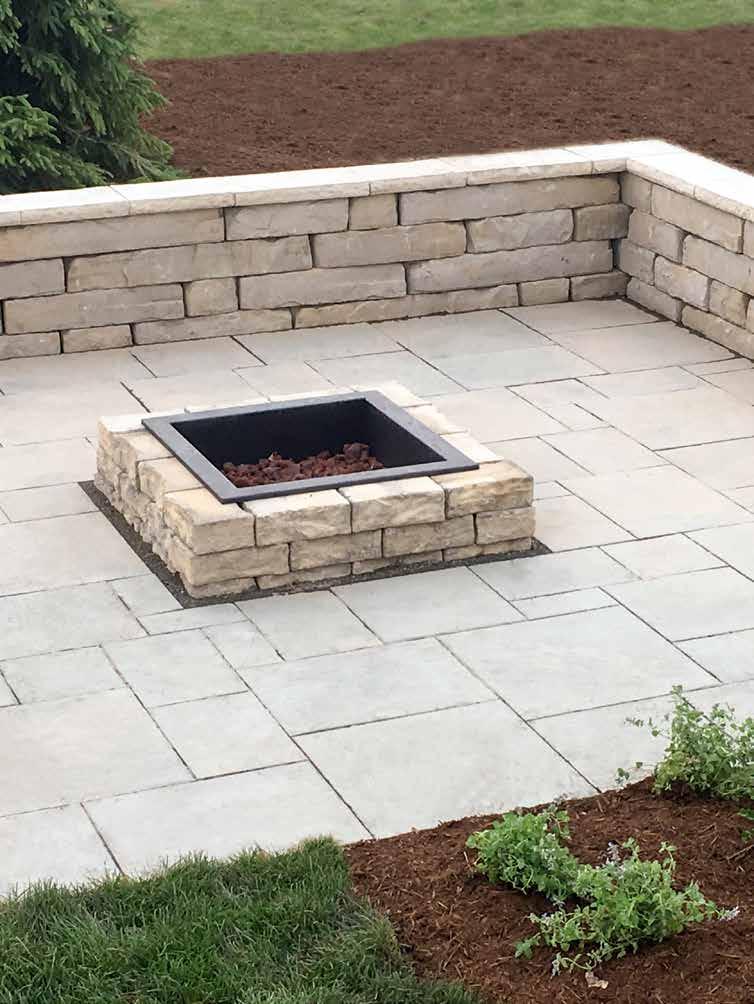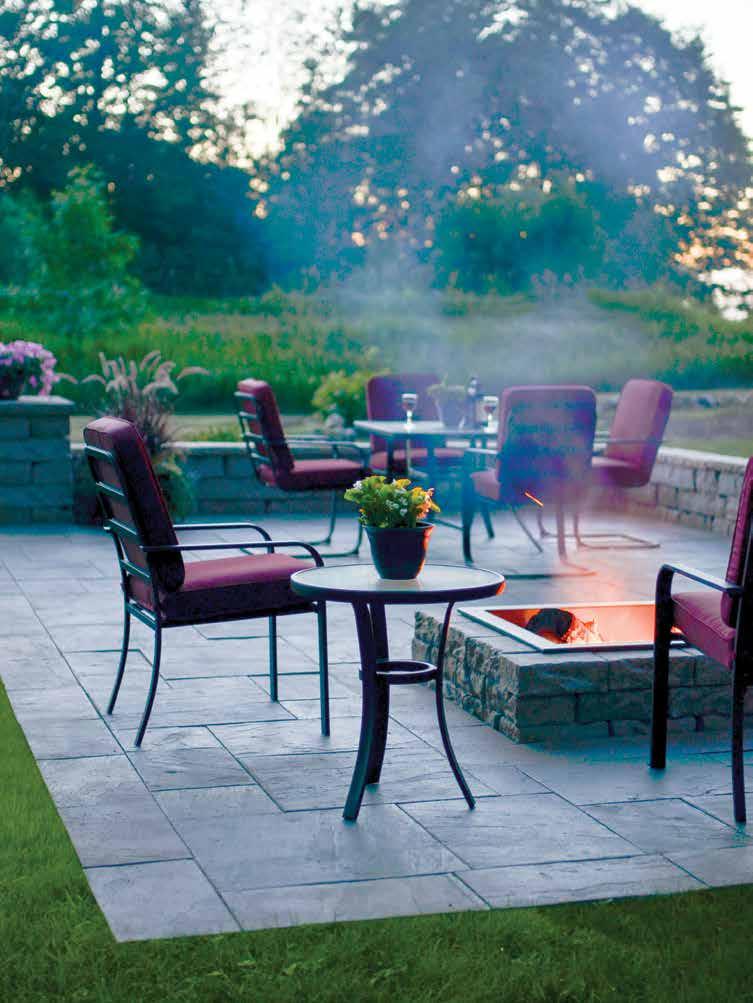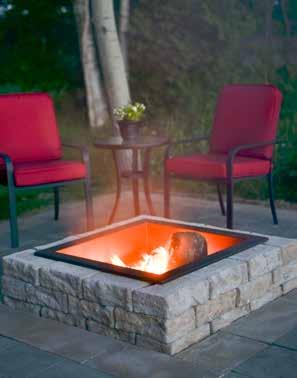
PRE-PLANNED PATIO DESIGN GUIDE


PRE-PLANNED PATIO DESIGN GUIDE
And your work just a got a lot more fun. With this Pre-Planned Patio Design Guide, selling and installing your customer’s dream patio will seem more like completing a life-sized puzzle than work.
With this simple, complete resource at your fingertips, you can bid, sell, and install patio after patio with Rosetta, without spending any extra time estimating and designing.
Rosetta Hardscapes products are easy to install and look more like natural stone than any other man-made product you can find. That makes Rosetta the premier hardscape option for you and your customers.
The patio designs contained in this guide are labeled as “rustic” and “formal” because some of your customers will want a laid back curvy design, and others will want a more formal, sleek design. Both sets include a range of options (A,B, and C) to cater to various budgets. There’s a patio for everyone—sell on, friend.
These reference materials detail many practical ways to create a beautiful outdoor living space with Rosetta Hardscapes’ line of natural looking wall and patio stones.
This document is intended as a supplement to the Rosetta Technical Guide, which contains detailed installation instructions for all Rosetta products. Get one from your local Rosetta dealer, or download the Technical Guide at RosettaHardscapes.com

A round patio says family, community, s’mores, and summer nights. For your customers that appreciate a natural backyard, consider showing them the Rustic Patio options. Each rustic option features Grand Flagstone slabs, Belvedere walls, and Round Fire Pit Kits for a real stone feel that you won’t find in any other hardscape line.
Diagram 1
Diagram 3
Diagram 4
RUSTIC PATIO: OPTION A
• Excavate a 20-foot x 22-foot area. Prepare a paver base as detailed in the Rosetta Technical Guide. Keep in mind during excavation that in the finished installation, the top of the Grand Flagstone will be a minimum of 8¾ inches above the lowest point of the excavated area.
• Once the base has been prepared, lay the Grand Flagstone in layers, as shown in Diagram 1.
• Once the Grand Flagstone is laid out, locate the center of the patio. From this center point, use a string and a carpenter’s pencil to draw two circles, one with a radius of 9 feet, the other with a radius of 2 feet 4½ inches, as shown in Diagram 2. These will be the outside circumference of the Grand Flagstone, and the circumference of the Round Fire Pit, respectively.
• Once the circles have been marked, trim the Grand Flagstone along the pencil line using a gaspowered cut-off saw with a diamond-coated concrete blade. A hand-grinder or smaller saw may be required to trim the smaller Round Fire Pit circle.
• Remove the trimmed flagstone pieces. If large or unused pieces remain, they can be used as informal stepping stone paths leading to or from the patio.
• Prepare the freestanding Belvedere Wall base along the perimeter of the patio, as detailed in the Rosetta Technical Guide. The finished freestanding wall will span 24 feet.
• Build the freestanding Belvedere Wall as shown in Diagram 3. Be sure to use landscape block adhesive between all courses of block.
• Install Dimensional Coping across the top of the freestanding Belvedere Wall. See Diagram 4 for approximate trimmed dimensions of the coping pieces to make the correct radius atop the wall. Begin with a finished end piece, and after that, alternate between long and short pieces to complete the radius. Check the pieces as you go to ensure that the radius is correct. The final finished end piece may need to be trimmed to a custom length. The coping will overhang the front and back of the wall by approximately 1¾ inches.
• Install the Round Firepit as detailed in the Rosetta Technical Guide.
• Secure the exposed perimeter of the Grand Flagstone with a low-profile paver edging. A minimum of one stake should be used for every two feet of paver edging (minimum 18 stakes).
• Sweep the patio of dust and debris. Install a jointing material such as paver sand or polymeric sand. Grade topsoil or other finish media to the secured edge of the Grand Flagstone. Plant grass, sod, or landscape plants as desired.
These tips are intended as a supplement to the Rosetta Technical Guide, which contains detailed installation instructions for all Rosetta products. Get one from your local Rosetta dealer, or download the Technical Guide at RosettaHardscapes.com.

Option B expands the patio’s footprint and gives your customers more room for entertaining to make the most of their backyards! With room for a fire pit and a dining set, this patio is a snap to install and easy on your customer’s budget.
3
24'x2' FREESTANDING BELVEDERE WALL BLOCK KEY PROFILE VIEW
Diagram 4
F = LONG FACE OF BLOCK B = SHORT FACE OF BLOCK
OPTIONAL PILLAR CONSTRUCTION
Weave the wall into the pillar for additional strength
(WEAVE THE WALL INTO THE PILLAR FOR ADDITIONAL STRENGTH) PLAN VIEW WALL ABUTTING PILLAR WALL CUTTING INTO PILLAR ALTERNATE COURSES AS REQUIRED
DIMENSIONAL COPING DIMENSIONS (ALTERNATE BETWEEN SHORT AND LONG PIECES) PLAN VIEW
OPTIONAL PILLAR CONSTRUCTION
APPROXIMATE DIMENSIONAL COPING DIMENSIONS (ALTERNATE BETWEEN SHORT AND LONG PIECES) PLAN VIEW
RUSTIC PATIO: OPTION B
• Excavate a 32-foot x 23-foot area. Prepare a paver base as detailed in the Rosetta Technical Guide. Keep in mind during excavation that in the finished installation, the top of the Grand Flagstone will be a minimum of 8¾ inches above the lowest point of the excavated area.
• Once the base has been prepared, lay the Grand Flagstone in layers, as shown in Diagram 1.
• Once the Grand Flagstone is laid out, use Diagram 2 to locate the placement of the radii that will be used to create the perimeter of the patio as well as the Round Fire Pit.
• Once the perimeter of the patio has been marked, trim the Grand Flagstone along the line using a gaspowered cut-off saw with a diamond-coated concrete blade. A hand-grinder or smaller saw may be required to trim the smaller Round Fire Pit circle.
• Remove the trimmed flagstone pieces. If large or unused pieces remain, they can be used as informal stepping stone paths leading to or from the patio.
• Prepare the freestanding Belvedere Wall base along the perimeter of the patio, as detailed in the Rosetta Technical Guide. The finished freestanding wall will span 24 feet plus 2 feet on each end for the Belvedere Columns.
• Build the freestanding Belvedere Wall as shown in Diagram 3. Be sure to use landscape block adhesive between all courses of block.
• When you get to the ends of the wall, the Grand Flagstone will have to be trimmed to accommodate the Belvedere Column. The column has a footprint of 24 inches x 24 inches.
• Construct the Belvedere columns as detailed in the Rosetta Technical Guide. (Optional: For additional wall stability, build the wall “into” the column as shown in Diagram 4.)
• Lay the New Mission patio border around the exposed patio edge. Trimming should not be necessary except for the final paver (there will be small gaps; this is fine).
• Secure the exposed perimeter of the New Mission Pavers with paver edging. A minimum of one stake should be used for every two feet of paver edging (minimum 30 stakes).
• Install Dimensional Coping across the top of the freestanding Belvedere Wall. See Diagram 3 for approximate trimmed dimensions of the coping pieces to make the correct radius atop the wall. Begin with a finished end piece, and after that, alternate between long and short pieces to complete the radius. Check the pieces as you go to ensure that the radius is correct. The final finished end piece may need to be trimmed to a custom length. The coping will overhang the front and back of the wall by approximately 1¾ inches.
• Place the column caps atop the Belvedere Columns.
• Install the Round Firepit as detailed in the Rosetta Technical Guide.
• Sweep the patio of dust and debris. Install a jointing material such as paver sand or polymeric sand. Grade topsoil or other finish media to the secured edge of the patio. Plant grass, sod or landscape plants as desired.
These tips are intended as a supplement to the Rosetta Technical Guide, which contains detailed installation instructions for all Rosetta products. Get one from your local Rosetta dealer, or download the Technical Guide at RosettaHardscapes.com.

Consider Option C your rustic “bells and whistles” offering. This fully-loaded design moves the focal point of the project from the Fire Pit to the Belvedere Fire Place, a feature that will inspire your customer without frustrating your installation crew.
4
Diagram 2
24'x2' FREESTANDING BELVEDERE WALL BLOCK KEY PROFILE VIEW
Diagram 5
F = LONG FACE OF BLOCK B = SHORT FACE OF BLOCK
OPTIONAL PILLAR CONSTRUCTION
Weave the wall into the pillar for additional strength
(WEAVE THE WALL INTO THE PILLAR FOR ADDITIONAL STRENGTH) PLAN VIEW WALL ABUTTING PILLAR WALL CUTTING INTO PILLAR ALTERNATE COURSES AS REQUIRED
OPTIONAL PILLAR CONSTRUCTION
APPROXIMATE DIMENSIONAL COPING DIMENSIONS (ALTERNATE BETWEEN SHORT AND LONG PIECES) PLAN VIEW
RUSTIC PATIO: OPTION C
• Excavate a 32-foot x 23-foot area. Prepare a paver base as detailed in the Rosetta Technical Guide. Keep in mind during excavation that in the finished installation, the top of the Grand Flagstone will be a minimum of 8¾ inches above the lowest point of the excavated area.
• Once the base has been prepared, lay the Grand Flagstone in layers, as shown in Diagram 1.
• Once the Grand Flagstone is laid out, use Diagram 2 to locate the placement of the radii that will be used to create the perimeter of the patio as well as the Round Fire Pit.
• Mark the outline of the footprint of the Belvedere Fire Place (+/- 72 inches x 44 inches). The Belvedere Fire Place can be located anywhere along the perimeter of the larger circle. The center of the front edge of the hearth is to be placed 67 inches from the center point of the circle.
• Once the perimeter of the patio and the footprint of the Belvedere Fire Place have been marked, trim the Grand Flagstone along the line using a gas-powered cut-off saw with a diamond-coated concrete blade. A hand-grinder or smaller saw may be required to trim the smaller Round Fire Pit circle.
• Remove the trimmed flagstone pieces. If large or unused pieces remain, they can be used as informal stepping stone paths leading to or from the patio.
• Install the Belvedere Fire Place as detailed in the Rosetta Technical Guide. A few pieces of flagstone may need to be removed during the installation of the Belvedere Fire Place.
• Prepare the freestanding Belvedere Wall base along the perimeter of the patio, as detailed in the Rosetta Technical Guide. The finished freestanding wall will span 24 feet plus 2 feet on each end for the Belvedere Columns.
• Build the freestanding Belvedere Wall as shown in Diagram 4. Be sure to use landscape block adhesive between all courses of block.
• When you get to the ends of the wall, the Grand Flagstone will have to be trimmed to accommodate the Belvedere Column. The column has a footprint of 24 inches x 24 inches.
• Construct the Belvedere columns as detailed in the Rosetta Technical Guide. (Optional: For additional wall stability, build the wall “into” the column as shown in Diagram 5.)
• Lay the New Mission patio border around the exposed patio edge. Trimming should not be necessary except for the final paver (there will be small gaps; this is fine).
• Secure the exposed perimeter of the New Mission Pavers with paver edging. A minimum of one stake should be used for every two feet of paver edging (minimum 25 stakes).
• Install Dimensional Coping across the top of the freestanding Belvedere Wall. See Diagram 6 for approximate trimmed dimensions of the coping pieces to make the correct radius atop the wall. Begin with a finished end piece, and after that, alternate between long and short pieces to complete the radius. Check the pieces as you go to ensure that the radius is correct. The final finished end piece may need to be trimmed to a custom length. The coping will overhang the front and back of the wall by approximately 1¾ inches.
• Place the column caps atop the Belvedere Columns.
• Install the Round Firepit as detailed in the Rosetta Technical Guide.
• Lay a Superior Stepping Stone walking path as shown in Diagram 3. See the Rosetta Technical Guide for detailed installation instructions.
• Sweep the patio of dust and debris. Install a jointing material such as paver sand or polymeric sand. Grade topsoil or other finish media to the secured edge of the patio. Plant grass, sod or landscape plants as desired.
These tips are intended as a supplement to the Rosetta Technical Guide, which contains detailed installation instructions for all Rosetta products. Get one from your local Rosetta dealer, or download the Technical Guide at RosettaHardscapes.com.

Not only does a square patio mean a formal, chic look for your customer, it means straightforward installation for you and your team. The Formal Patio options in this guide feature Kodah Walls, Dimensional Flagstone slabs, and the Rosetta Square Fire Pit, for visuallystriking linear proportions and as little concrete cutting as possible.
FORMAL PATIO: OPTION A
1
See page 26 for construction tips
Diagram 2
FORMAL PATIO: OPTION A
• Excavate a 17-foot x 17-foot area where the patio will be located. Prepare a paver base as detailed in the Rosetta Technical Guide. Keep in mind during excavation that in the finished installation, the top of the Dimensional Flagstone will be a minimum of 9 inches above the lowest point of the excavated area.
• Once the base has been prepared, lay the Dimensional Flagstone as shown in the pattern on Diagram 2. This pattern will allow you to build the patio utilizing all of the flagstone with no wasted pieces, and with no need to trim pieces.
• Prepare the freestanding Kodah Wall base along the perimeter of the patio, as detailed in the Rosetta Technical Guide. The finished freestanding wall will span two adjoining sides of the patio.
• Starting in the corner, build the freestanding Kodah wall as detailed in the Rosetta Technical Guide. Use corner blocks on the ends and corner of the wall. Be sure to use landscape block adhesive between all courses of block.
• Install Dimensional Coping across the top of the freestanding Kodah Wall as detailed in the Rosetta Technical Guide. Use landscape block adhesive to adhere the coping to the wall. The coping will overhang the front and back of the wall approximately 1 inch. Trimming may be required on 1-3 pieces of coping.
• Install the Square Fire Pit as detailed in the Rosetta Technical Guide. There will be approximately a 2-inch gap between the Square Fire Pit and the Dimensional Flagstone.
• Secure the exposed perimeter of the Dimensional Flagstone with a low-profile paver edging. A minimum of one stake should be used for every two feet of paver edging (minimum 16 stakes).
• Sweep the patio free of dust and debris. Install a jointing material such as paver sand or polymeric sand. Grade topsoil or other finish media to the secured edge of the Dimensional Flagstone. Plant grass, sod or landscape plants as desired.
These tips are intended as a supplement to the Rosetta Technical Guide, which contains detailed installation instructions for all Rosetta products. Get one from your local Rosetta dealer, or download the Technical Guide at RosettaHardscapes.com.

Option B extends the surface area of the Formal Patio, so that your customer can dream a little bit bigger about their weekend plans. And with the impressive look and no-nonsense installation of Kodah wall, you’ll be your customer’s hero without having to spend your weekend installing hardscapes.
Diagram 1
Diagram 4
OPTIONAL PATIO VARIANT
To install the formal patio without a fire pit, add (3) sections of Dimensional Flagstone in place of the Square Fire Pit, and utilize this installation pattern to fill the void in the patio where the firepit would be
FORMAL PATIO: OPTION B
See page 34 for construction tips
• Excavate a 30-foot x 20-foot area where the patio will be located. Prepare a paver base as detailed in the Rosetta Technical Guide. Keep in mind during excavation that in the finished installation, the top of the Dimensional Flagstone will be a minimum of 9 inches above the lowest point of the excavated area.
• Once the base has been prepared, lay the Dimensional Flagstone as shown in the pattern on Diagram 2. This pattern will allow you to build the patio utilizing all of the flagstone with no wasted pieces, and with minimal trimming.
• Install the Linear Flagstone border around the perimeter of the Dimensional Flagstone, and along the interior of the Square Fire Pit area. Some trimming of Linear Flagstone pieces will be required to complete the installation. Also, make note of the location of the Kodah Columns, as they interrupt the Linear Flagstone Border.
• Prepare the freestanding Kodah Wall base along the perimeter of the patio, as detailed in the Rosetta Technical Guide. The finished freestanding wall will span two adjoining sides of the patio.
• Starting in the corner, build the freestanding Kodah wall as detailed in the Rosetta Technical Guide. Be sure to use landscape block adhesive between all courses of block. The freestanding Kodah Wall will be four courses high (18 inches above finish grade before the coping is installed).
• Construct the Kodah columns as detailed in the Rosetta Technical Guide. (Optional: for additional wall stability, build the wall “into” the column as shown in Diagram 3.)
• Install Dimensional Coping across the top of the freestanding Kodah Wall as detailed in the Rosetta Technical Guide. Use landscape block adhesive to adhere the coping to the wall. The coping will overhang the front and back of the wall approximately 1 inch.
• Place the column caps atop the Kodah Columns.
• Install the Square Fire Pit as detailed in the Rosetta Technical Guide. There will be approximately a ½-inch gap between the Square Fire Pit and the Linear Flagstone. (Optional: to install the patio without a Square Fire Pit, follow the guide in Diagram 4.)
• Secure the exposed perimeter of the Linear Flagstone with a low-profile paver edging. A minimum of one stake should be used for every two feet of paver edging (minimum 30 stakes).
• Sweep the patio free of dust and debris. Install a jointing material such as paver sand or polymeric sand. Grade topsoil or other finish media to the secured edge of the Dimensional Flagstone. Plant grass, sod or landscape plants as desired.
These tips are intended as a supplement to the Rosetta Technical Guide, which contains detailed installation instructions for all Rosetta products. Get one from your local Rosetta dealer, or download the Technical Guide at RosettaHardscapes.com.



The Party Patio. The Whole Shebang. Fancy Pants Patio. Whatever you call it, this is a patio designed to wow. Formal Option C features an elegant Claremont Fireplace and patterned Dimensional Flagstone pavers. The fireplace is comprised of 5 large precast pieces, for fast and easy installation.
Rosetta Patio Templates 2016 [revision 2].dwg
FORMAL PATIO: OPTION C
Diagram 1
Diagram 3
OPTIONAL PILLAR CONSTRUCTION
Weave the wall into the pillar for additional strength
OPTIONAL PATIO VARIANT
To install the formal patio without a fire pit, add (3) sections of Dimensional Flagstone in place of the Square Fire Pit, and utilize this installation pattern to fill the void in the patio where the firepit would be
Diagram 5
CLAREMONT FIREPLACE
FORMAL PATIO: OPTION C
• Excavate a 30-foot x 20-foot area where the patio will be located. Prepare a paver base as detailed in the Rosetta Technical Guide. Keep in mind during excavation that in the finished installation, the top of the Dimensional Flagstone will be a minimum of 9 inches above the lowest point of the excavated area.
• Once the base has been prepared, lay the Dimensional Flagstone as shown in the pattern on Diagram 5. This pattern will allow you to build the patio utilizing all of the flagstone with no wasted pieces, and with minimal trimming.
• Install the Linear Flagstone border around the perimeter of the Dimensional Flagstone, and along the interior of the Square Fire Pit area. Some trimming of Linear Flagstone pieces will be required to complete the installation. Also, make note of the location of the Kodah Columns, as they interrupt the Linear Flagstone Border.
• Mark the outline of the footprint of the Claremont Fire Place (+/- 72 inches x 44 inches) as detailed in Diagram 5. When the footprint of the Claremont Fire Place has been marked and confirmed, trim the Dimensional Flagstone and Linear Flagstone.
• Install the Claremont Fire Place as detailed in the Rosetta Technical Guide. A few pieces of flagstone may need to be removed during the installation of the fire place.
• Prepare the freestanding Kodah Wall base along the perimeter of the patio, as detailed in the Rosetta Technical Guide. The finished freestanding wall will span two adjoining sides of the patio.
• Starting in the corner, build the freestanding Kodah wall as detailed in the Rosetta Technical Guide. Be sure to use landscape block adhesive between all courses of block. The freestanding Kodah Wall will be four courses high (18 inches above finish grade before the coping is installed).
• Construct the Kodah columns as detailed in the Rosetta Technical Guide. (Optional: for additional wall stability, build the wall “into” the column as shown in Diagram 3.)
• Install Dimensional Coping across the top of the freestanding Kodah Wall as detailed in the Rosetta Technical Guide. Use landscape block adhesive to adhere the coping to the wall. The coping will overhang the front and back of the wall approximately 1 inch.
• Place the column caps atop the Kodah Columns.
• Install the Square Fire Pit as detailed in the Rosetta Technical Guide. There will be approximately a ½-inch gap between the Square Fire Pit and the Linear Flagstone. (Optional: to install the patio without a Square Fire Pit, follow the guide in Diagram 4.)
• Secure the exposed perimeter of the Linear Flagstone with a low-profile paver edging. A minimum of one stake should be used for every two feet of paver edging (minimum 30 stakes).
• Sweep the patio free of dust and debris. Install a jointing material such as paver sand or polymeric sand. Grade topsoil or other finish media to the secured edge of the Dimensional Flagstone. Plant grass, sod or landscape plants as desired.
• Lay a Linear Flagstone walking path as shown in Diagram 2. See the Rosetta Technical Guide for detailed installation instructions.
These tips are intended as a supplement to the Rosetta Technical Guide, which contains detailed installation instructions for all Rosetta products. Get one from your local Rosetta dealer, or download the Technical Guide at Rosettahardscapes.com.
